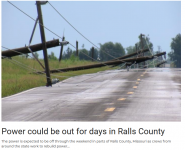petersonra
Senior Member
- Location
- Northern illinois
- Occupation
- Semi-retired engineer
There is nothing that can be done that will make electrical lines perfectly reliable, especially when dealing with widespread natural disasters. But you can harden them to the more common failures that affect large numbers of customers at a time. Not going to do any real good during floods or earthquakes though.


